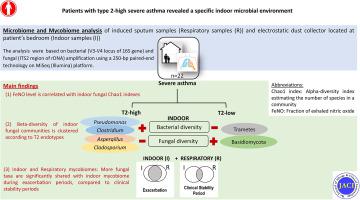Journal of Allergy and Clinical Immunology ( IF 11.4 ) Pub Date : 2020-09-12 , DOI: 10.1016/j.jaci.2020.08.035 Louise-Eva Vandenborght 1 , Raphaël Enaud 2 , Charlotte Urien 3 , Noémie Coron 4 , Pierre-Olivier Girodet 2 , Stéphanie Ferreira 3 , Patrick Berger 2 , Laurence Delhaes 2

|
Background
The links between microbial environmental exposures and asthma are well documented, but no study has combined deep sequencing results from pulmonary and indoor microbiomes of patients with asthma with spirometry, clinical, and endotype parameters.
Objective
The goal of this study was to investigate the links between indoor microbial exposures and pulmonary microbial communities and to document the role of microbial exposures on inflammatory and clinical outcomes of patients with severe asthma (SA).
Methods
A total of 55 patients with SA from the national Cohort of Bronchial Obstruction and Asthma cohort were enrolled for analyzing their indoor microbial flora through the use of electrostatic dust collectors (EDCs). Among these patients, 22 were able to produce sputum during “stable” or pulmonary “exacerbation” periods and had complete pairs of EDC and sputum samples, both collected and analyzed. We used amplicon targeted metagenomics to compare microbial communities from EDC and sputum samples of patients according to type 2 (T2)-asthma endotypes.
Results
Compared with patients with T2-low SA, patients with T2-high SA exhibited an increase in bacterial α-diversity and a decrease in fungal α-diversity of their indoor microbial florae, the latter being significantly correlated with fraction of exhaled nitric oxide levels. The β-diversity of the EDC mycobiome clustered significantly according to T2 endotypes. Moreover, the proportion of fungal taxa in common between the sputum and EDC samples was significantly higher when patients exhibited acute exacerbation.
Conclusion
These results illustrated, for the first time, a potential association between the indoor mycobiome and clinical features of patients with SA, which should renew interest in deciphering the interactions between indoor environment, fungi, and host in asthma.
中文翻译:

2 型重度哮喘与特定的室内真菌群和微生物群有关
背景
微生物环境暴露与哮喘之间的联系已得到充分证明,但尚无研究将哮喘患者肺部和室内微生物组的深度测序结果与肺活量测定法、临床和内型参数相结合。
客观的
本研究的目的是调查室内微生物暴露与肺部微生物群落之间的联系,并记录微生物暴露对严重哮喘 (SA) 患者的炎症和临床结果的作用。
方法
共有来自国家支气管阻塞和哮喘队列的 55 名 SA 患者被招募,通过使用静电除尘器 (EDC) 分析他们的室内微生物菌群。在这些患者中,22 名能够在“稳定”或肺部“恶化”期间产生痰液,并收集和分析了完整的 EDC 和痰液样本对。我们使用扩增子靶向宏基因组学根据 2 型 (T2) 哮喘内型比较来自 EDC 和患者痰样本的微生物群落。
结果
与 T2 低 SA 患者相比,T2 高 SA 患者的室内微生物菌群的细菌 α 多样性增加,真菌 α 多样性降低,后者与呼出的一氧化氮水平分数显着相关。根据 T2 内型,EDC 菌群的 β 多样性显着聚集。此外,当患者表现出急性加重时,痰液和 EDC 样本之间共有的真菌类群比例明显更高。
结论
这些结果首次说明了室内真菌群与 SA 患者临床特征之间的潜在关联,这应该重新引起人们对破译室内环境、真菌和哮喘宿主之间相互作用的兴趣。











































 京公网安备 11010802027423号
京公网安备 11010802027423号